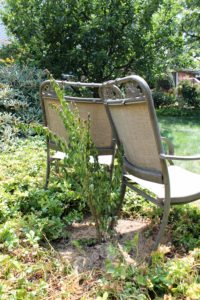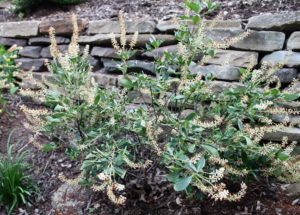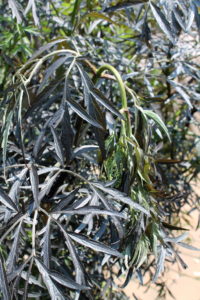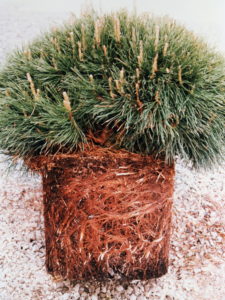Transplant Shock
October 6th, 2020
New plants often look like they’re having a near-death experience almost as soon as we put them in the ground.
They’ll wilt, yellow, turn brown around the leaf edges, and maybe even drop leaves and needles, scaring us into thinking we’ve killed the poor things right off the bat.
And that sometimes is the case.
However, more times than not, these alarming symptoms are temporary and a result of a common gardening phenomenon called “transplant shock.”
Transplant shock is a plant’s way of letting you know it’s not happy about getting evicted from its cozy pot and coddled nursery care and moving into the real world of lousy clay, erratic weather, and iffy watering.
It’s not an easy transition. Much can go wrong. In fact, other than moving into deer territory, going into the garden is usually the biggest challenge a plant will face.
We might not be able to completely erase transplant shock, but there’s a lot we can do to minimize it.
The effort begins at plant-picking time.
Since we’re generally starting with small plants and limited root systems, it pays to make sure those few roots are as big and healthy as we can find them.
Way too many plant-shoppers choose based on what they see above ground, i.e. the bigger the canopy or plant size, the better.
Personally, I’d rather have a plant with a bigger root ball and less top growth than a big plant with a comparatively little root ball.
The well drained plant medium in most nursery pots makes root-rotting in soggy soil unlikely, but it’s entirely possible roots have died from under-watering.
I’ve seen wilted plants on retail plant benches, more often in box stores than independent garden centers where the help can be stretched thin. Those plants already are compromised.
So are plants that have been growing in the same pot for too long. Those roots begin to circle and crowd the pot, limiting their ability to nourish the top growth with moisture and nutrients.
That doesn’t mean a “pot-bound” plant is doomed, but it’ll mean you have to fray out the circling, matted roots so they’re free to venture into the surrounding soil.
Badly circled roots that aren’t freed can stunt and kill a plant, which is why conventional advice is to go so far as to make vertical cuts in the roots rather than plant a tight ball as is.
It’s always better to try your best to free roots without damaging them. Washing the soil from the rootball helps.
One of the most overlooked transplant-shock troubles involves how we get our plants home.
I’ve seen gardeners stack unprotected evergreens, perennials, and leafed-out trees and shrubs in the back of their pickup for the trip home. That drive down the highway is like exposing your plants to near-hurricane winds, creating moisture deficits and wind-burned plants even before they’re planted.
Either store plants inside your vehicle or cover them with burlap, a sheet, or a tarp for the ride home.
When you plant makes a huge difference, too.
With annual flowers and vegetables that you’ve bought from inside a greenhouse, give them a few days of increasing light and air outside before planting them.
It’s possible those plants have never seen the light of day – going from a production greenhouse directly into a retail greenhouse. If they’re suddenly taken out and planted, they can wilt, bleach, and maybe even die from the sudden bright light and drying outdoor air.
With all plants, it’s best to plant them on a cloudy day. This lets you transplant without the plant being immediately blasted by full sun.
Cloudy days draw less moisture from plants than sunny days and make the transition into the ground less taxing.
If you plant on a cloudy day right before a soaking rain, so much the better. The roots will get a comforting bath right off the bat.
If you can’t avoid sunny-day transplants, wait until evening to plant. The transplants will get a nighttime break first thing before having to face bright sun.

It might not look the greatest, but these chairs are giving a newly planted little tree some temporary sun protection.
Another option is placing a temporary barrier, such as a burlap shield or similar shading device, between the new plant and the sun to give the plant some time to adjust to the brighter light.
Season-wise, early spring and early fall are two of the best shock-easing windows.
In summer, sunlight is at its piercing peak, not to mention our ever-increasing heat that sucks moisture from the foliage almost as fast (and sometimes faster) than the roots can resupply it.
In late fall (November and beyond), roots don’t have enough time to establish before the ground gets too cold, opening them to having the rootballs “heave” partially above ground during late-year freezing and thawing. If that happens, tamp them back into the ground ASAP.
Most plants also transplant best when they’re not in full bloom. We often violate that little factor because we’re most drawn to buy plants when they’re blooming.
Some plants are OK with that, but species such as roses, hydrangeas, and caryopteris often droop their blooming stems after planting no matter what you do.
Picking the right site is important, both in the short term and long term.
Shade-preferrers, for example, are never going to be happy in a full-sun site… and vice versa.
Sometimes even site-suited plants will shock from the change in light or soil type. Most plants will adapt to the new conditions, but some of them will drop their foliage before regrowing a new set of leaves.
For the gardener, that’s a touch-and-go time because there’s uncertainty whether the foliage drop is a case of adjusting to the new site or croaking altogether.
Planting depth, soil quality, and the amount of root damage done during the transplant are three factors involved in that difference.
Read George’s post on “So You Think You Know How to Plant a Tree?”
Read George’s post on “Rethinking the Way We Plant, Part 1”
Read George’s post on “Rethinking the Way We Plant, Part 2”
Which brings us to maybe the most important part of all – watering.
This one often fakes out gardeners since wilting plants can be a sign of not enough water (soil is too dry) or too much water (roots have died in soggy soil and can’t supply the top growth with moisture).
Step one is to soak the soil around your transplanted plants immediately after planting to settle air pockets and make sure the roots are in contact with damp soil.
Make sure you’ve watered enough to wet the whole way around the rootball and down to just below the bottom of the rootball.
Do this even if it’s supposed to rain. Forecasts aren’t always right, and rains don’t always dampen as deeply as you think.
Keep the soil consistently damp the entire first growing season by watering whenever rain doesn’t do the deed for you. Continue to water in fall up until the ground freezes.
Your index finger – stuck a few inches into the ground – is one of the best tools for determining whether it’s time to water or not.
Read George’s tips on watering
There’s no need to fertilize most plants at planting time. Despite being one of the first things a gardener is apt to do after seeing transplant shock happen, fertilizing doesn’t help and may even make things worse if you overdo it.
There’s some evidence that products with mycorrhizal fungi and other transplant-aid products help establish plants, but they’re not essential. Personally, I don’t use them and have had pretty good plant-survival success over the years.
Read Dr. Linda Chalker-Scott’s research rundown on vitamin stimulants for transplant shock
Some people also spray new or to-be-transplanted plants with anti-transpirant sprays, such as Wilt-Pruf and No Wilt Plant Shield. These contain resins that block the stomata (pores) on plant foliage and slow the evaporation loss that can factor into wilting. Again, I don’t use these.
Read Dr. Linda Chalker-Scott’s research rundown on anti-transpirants
If the weather cooperates, the deer stay away, and you’re good with your watering, signs of transplant shock should begin to ease in a week or two.
By next year, the plant should be looking pretty good.
Just stay on top of watering if/when it turns hot and dry then, and don’t worry if it seems like the plant isn’t growing very much.
New plants often focus on root growth the first year or two before kicking into prime growth speed once the roots are in place to support it.
For more on how to transplant existing plants, Read George’s post on “transplantaphobia”










